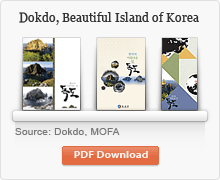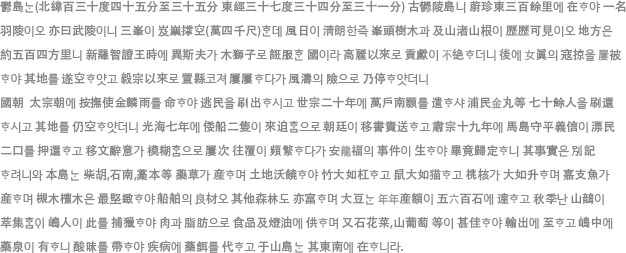



![]() > Media Center > Dokdo, the First Victim of Japan’s Aggression Against the Korean Peninsula > The Korean Empire’s Jurisdiction Over Dokdo
> Media Center > Dokdo, the First Victim of Japan’s Aggression Against the Korean Peninsula > The Korean Empire’s Jurisdiction Over Dokdo
Daehan-Shinjiji
Uldo (130 degrees 45 minutes to 35 minutes north latitude and 37 degrees 34 minutes to 31 minutes east longitude) is the old Ulleungdo and is located some 300li (118km) east from Uljin (of Gyeongsangbuk-do Province). It is also called Ureung or Mureung. Three mountains seem to prick the sky, and in fine weather, the trees on the summits and the sandy planes at the foot can be clearly seen. The land stretches some 500li (196km) on all directions. There used to be an ancient kingdom which Isabu, a general of the Silla Kingdom, subjugated during the reign of King Jijeung by using wooden lion statues to deceive the people into surrender. People on the island had never stopped offering tributes since the Goryeo dynasty, but it was often plundered by the Jurchens and eventually became completely abandoned. There had been attempts to establish a prefecture there since the reign of King Uijong of Goryeo, but all were foiled by storms. During the reign of King Taejong of Joseon, an envoy Kim In-u was ordered to go to the island and bring back people who had fled there. In the 2oth year of King Sejong’s reign, a military officer, Nam Ho, was sent to bring back some 70 people who had fled there including Kim Hwan, leaving the island empty. In the 7th year of Prince Gwanghae’s reign (1615), two Japanese ships came to the island and the royal court sent an official document to repatriate them. When Tsushima Daimyo Yoshinobu Taira (wrong indication of Yoshitsugu So) repatriated two castaways, the meaning of the inquiry documents was vague, incurring frequent exchanges of documents and escalating into the An Yong-bok incident. However, it was resolved in a proper way. This will be separately described. This island produces medicinal herbs such as Bupleurum (Bupleurumfalcatum), heathgrass, and ligusticum sinense oliver. The soil is so fertile that bamboo trees are as large as flagpoles, mice as cats, and peach pits as gourd bowls used as measures. Sea lions can be found here. Ash and birch trees that grow on this island are very hard, enough to be good lumber to build boats. It is also rich in other kinds of trees. The island annually produces 500 to 600 bags of beans and, in autumn, streaked shearwater birds gather here, which the residents catch to use their flesh and fat as food and lamp oil. Agar-agar, Korean wild grapes, and other foods produced on the island are delicious and are exported. There is a spring in the island that produces medicinal water; it tastes sour but serves as medicine to treat disease. To the southeast of this island is Usando (Dokdo).
* Daehan-Shinjiji is a geography textbook written by Jang Ji-yeon, and the above is found in Chapter 6, Gyeongsangbuk-do Province of its Volume 2.
